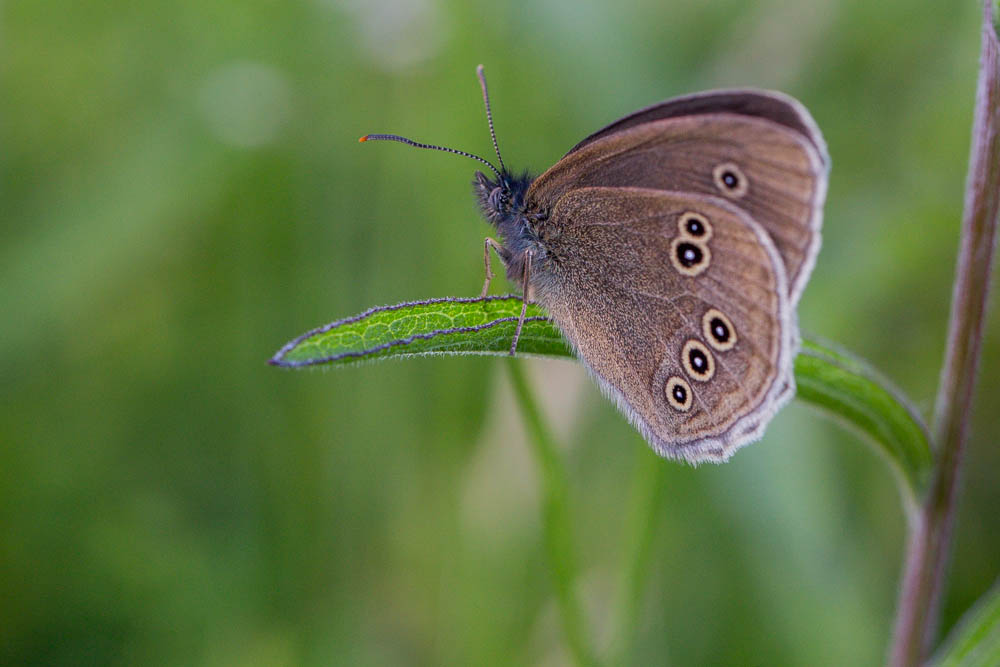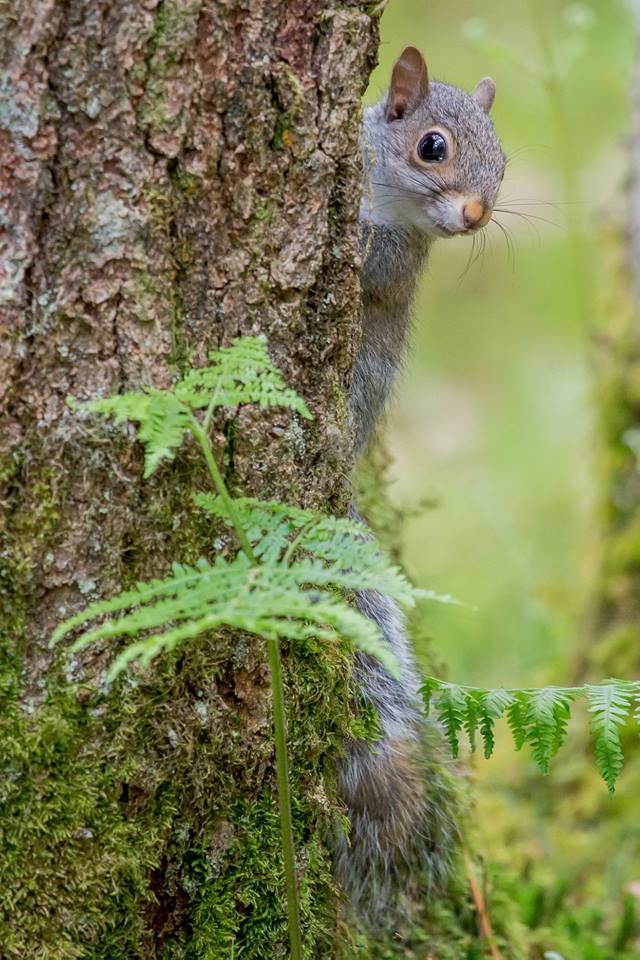
Mammals
The majority of the Estate is included in a Special Protection Area under the EC Directive on Wild Birds and falls within the Cambrian Mountains Environmentally Sensitive Area. The Estate is home to a wide range of wildlife, many species thriving and in good numbers, others more perilous and in need of careful stewardship.
There are over 20 species of mammal in the Claerwen and Elan Valleys, most are nocturnal and wary of man and are therefore rarely seen. Grey Squirrels of course are common and easy to see; they come originally from America and are larger and more adaptable than the native Red Squirrel. There are no records of reds since the 1960s and one of the last in Radnorshire was at Penygarreg Woods.
According to estate tenants, red squirrels were last spotted in the 1940s, where they remember seeing red squirrels playing at Penygarreg next to the engineer’s bungalow and along the woodlands to Henfron farm. The nearest population is in the Tywi forest which borders onto the Estate and about 10 years ago the farmer adjacent to the forest boundary saw a couple of young red squirrels sitting on the fence posts with their distinct ear tufts in view. The grey squirrels can be a nuisance on the estate by destroying some of the pied flycatcher bird boxes, though the buzzard is often on the prowl for a squirrel supper.
There are only occasional records of Deer on the Estate, three species have been recorded infrequently; these being Red, Roe and Muntjac Deer. There are three red deer records; one dating back to 1900’s, one male who turned up at Ciloewynt, Claerwen Valley in the farmyard in the 1980’s where there is a photo to confirm this record. A further report was also from the Claerwen of a few large deer about 8 years ago though not confirmed. A dead Muntjac deer was recorded along Henfron track in the 1990,s though there have been no records since. There have been reported sightings by farmers of Muntjac between the valley and Rhayader. In 2018 a local Natural History group captured a Muntjac deer on a trail camera which confirms they are close by. It is hoped the local mammal group by placing out trail cameras on the estate may find some further confirmed records. The third deer species seen is the Roe Deer and over the last few years there have been a number of sightings. A doe was discovered by farmer with twin fawns in the Gro and a Male and a Female have been recorded from around Penygarreg. The occasional Male has also been heard barking in the Autumn Rutting season.
Foxes mostly live alone and usually adapt old rabbit or badger burrows into earths which are used for shelter and for females to raise cubs in. Vixens can be heard calling in the September and that blood curdling scream she does can be heard in the hillsides.
Badgers, Otters, Polecats, Pine marten, Mink, Stoats and Weasels are all members of the weasel (mustelid) family which are found in the valleys. Badgers are strong burrowers and live in setts as family groups. As well as the main sett which is always in use, they may have other smaller setts in their territory which they only use occasionally. Otters are periodically seen on the Estate and they do use our rivers, reservoirs and lakes as fishing grounds for brown trout. Very often in the spring you can find the legs of frogs next to pools, the evidence that otters are in the vicinity and feeding on the glut of amphibians. These long slender creatures have a dense coat with brown above and cream below which keeps them well insulated and adapted for an aquatic life. The thick tale is used as a rudder to propel them through the water. Otter spraints (poop) can be found on the reservoir, stream edges and under bridges, it is tarry black and not unpleasant to smell.

Polecats are uncommon outside of Wales and its bordering counties although the population is spreading. They are the wild cousins of domestic ferrets with which they will interbreed. The facial markings are great distinguishing feature as they are said to resemble a bandit’s mask across the eyes. Stoats and Weasels are often confused, both are chestnut brown with a white belly but Stoats are larger, with a black tipped tail and the line where the brown fur meets the white fur is straight. Weasels have a shorter, untipped, tail and a wavy line between the brown and white. Both of these are found on the estate Weasels more so in areas of drystone walls and most records are around the Claerwen Valley. The stoat is seen more regularly and there are reports of individuals in “Part Ermine”, where due to the harsh winter weather the stoats coat has started to turn white.
American Mink escaped from fur farms mostly during the 1960s and 1970s, they bred in the wild and spread near to the Estate by the late 1980s. There for 20 years there had been no records of mink on the actual estate until in 2016. This was not good news as the catchment holds populations of water voles. Mink are often found near to water where they prey on birds, small mammals and fish. Ground nesting ducks suffer from predation as the mink take eggs, chicks and adult birds. Water voles numbers have reduced nationally in streams and rivers where mink occur. Otters are believed to be a deterrent to mink within a habitat.
Pine marten are an exciting mammal that we hope to record more of. Found mostly within their strongholds of Scotland and Ireland with a potentially a small number still hanging on in Wales and the borders having been nearly hunted to extinction by man. The Vincent Wildlife Trust working with local landowners and farmers in the Cwmystwyth, Devils Bridge and Hafren area have restocked the area with a number of pine marten individuals which have then been recorded to have gone on and produced young. Pine Marten are woodland specialists and it is these habitats that provide all the needs for the species they very rarely will venture onto open ground where they can become prey to foxes. Though they will always remain a rarity it is possible that it could be something we see more of in our Welsh Countryside.
Moles are surprisingly common here even up on the highest moorland spots. They are not very often seen but their signs of activity are visible all over the landscape. Hedgehogs are uncommon on the Estate with records mainly from the Elan Village and Elan Valley hotel area. There are records up to Penbont Bridge and none in the Claerwen Valley. Interestingly there has been a population found at Bodtalog Farm in which is surrounded by upland habitat and very few trees! The farmers here managed to record at least 5 individuals coming to the dog’s food in the yard. Their main natural predator in Britain is the Badger and they are prone to being hit by traffic.
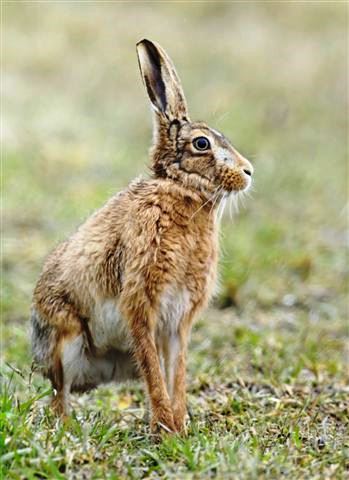
Rabbits are widespread but uncommon because they have many predators here including foxes, polecats, buzzards and kites. Brown Hares are rare but sightings seem to have increased in the last few years; Mountain Hares do not occur here. Brown hare records have been collected around Garreg Ddu, Dolymynach, Ciloerwynt and the Aberystwyth Mountain road areas.
Small Mammals occur all over the Estate in every habitat they are especially important food sources for so many of the larger mammals. Shrews are insectivores with very large appetites; they need to eat every 3-4 hours. We have 3 types of shrew, the Common, the Pygmy and the Water Shrew which has been found at Dol-y-mynach, Penygarreg and Penbont. Woodmice and Yellow Necked mice are common especially in broadleaved woodlands on the Estate and provide an important source of food for Tawny owls. House Mice have never been recorded on the estate. Brown Rats are seen and mostly recorded around farms.
There are also three types of vole, Bank, Field and Water Voles. Field/Short-Tailed Voles are an important source of food to many upland animals and birds of prey. Field Voles are generally found in grasslands and bank voles more in woodlands, drystone walls and banks. Bank voles are redder in colour with a slightly longer tail to its body than its larger browner cousin (Short Tailed Field Vole) with its shorter tail relative to its body length.
Water Voles were an exciting new discovery in the early 2000’s, where vast surveys were undertaken along the rivers, streams, ponds and ditches. Many populations were identified and The Elan Valley was made the first Upland National Key Area for water voles. Water voles are generally associated with canals and lowland watercourses so the discovery of upland populations in Wales and Scotland were exciting. The water vole has sadly decreased since the release of the American mink by 95%. It is a very vulnerable species to extinction. Water Voles are territorial through the breeding season marking their territories with tic-tac sized and shaped piles of green droppings.
Bats
Bats are found of course within the Estate and are a great indicator of the habitats in which they are found. There are 900 species of bats in the world and only about 16 occur in the UK. There are currently nine species recorded here in the Elan Valley which include the smallest pipistrelle to the largest Noctule. Species are Common Pipistrelle, Soprano Pipistrelle, Brown Long Eared, Daubenton, Lesser Horseshoe, Natterers, Brants, Whiskered and Noctule. Not recorded as yet but there is every hope that there may be barbastelle within the valleys.
Wherever your feet may take you out into the local countryside, keep in mind the more elusive mammals. If you take a little time to learn their field signs you can soon find and learn about what is around you.
If you do record any interesting mammals please do send your sightings to Radnorshire Mammal Group.

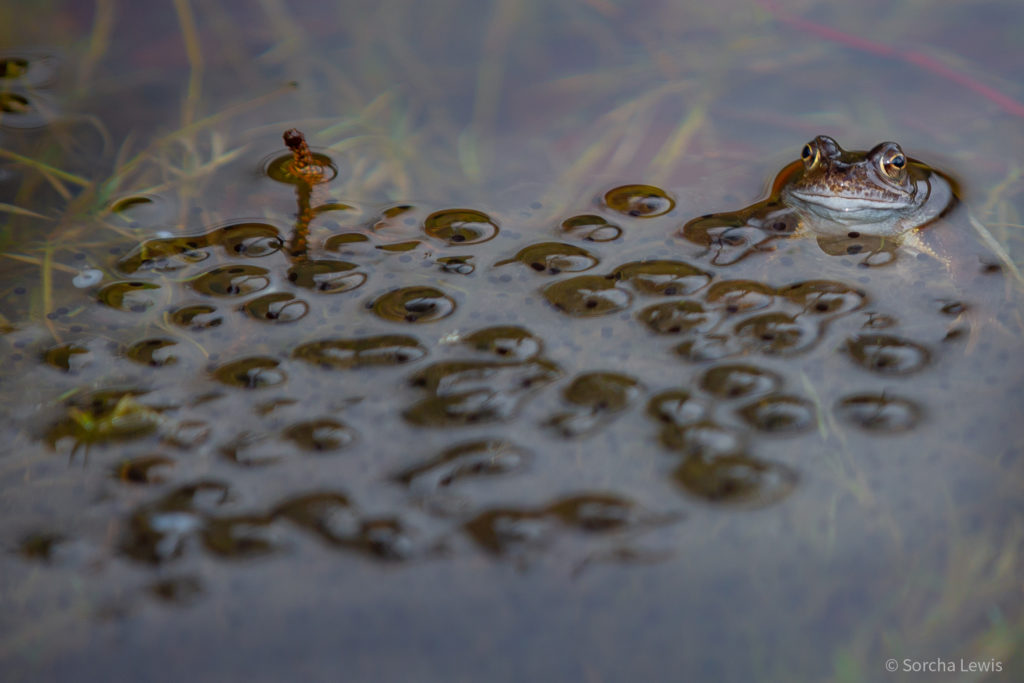
Amphibians and Reptiles
Our amphibians and reptiles are known collectively as herpetofauna and are key indicators of the health of our environment. Eleven species occur in Wales and of these six live in the Elan Valley. Amphibians and reptiles are found across a wide variety of habitats in Wales and their distribution is largely defined by climate and vegetation structure.
Amphibians require water courses such as ponds and slow moving water to use as breeding and feeding sites. They also require shelter in which to hibernate over the winter months such as woodland or long piles.
Our Elan Valley Amphibians are:
Common Frog
The Common Frog is easily our most recognisable amphibian. Dark patches on the back, stripes on the hind legs, and a dark ‘mask’ behind the eye. They’re found throughout Britain and Ireland, in almost any habitat where suitable breeding ponds are nearby. Common Frogs have smooth skin and long legs for jumping away quickly from predators.
Common Toad
Common toads are broad and squat with warty skin and vary from dark brown and olive green. They tend to walk rather than hop. Toads excavate a shallow burrow that they return to after foraging for prey of usually slugs, worms and invertebrates. They secrete an irritant substance from their skin and puff themselves up to deter predators. Common toads tend to spend much of their life away from water, except when mating and laying eggs. They hibernate during the winter in deep leaf litter, log piles and in burrows.
What is the difference between a frog and a toad? Frogs have smooth, moist skin and long, stripy legs and are likely to be found in damp habitats in the garden. Toads have warty skin, golden eyes and prefer to crawl rather than hop; if threatened a toad can puff itself up to appear bigger. Toads can tolerate drier habitats than frogs and spend less time in water.
Palmate Newt
Palmate Newts look very similar to the smooth newt though they have more of a preference for shallow ponds on acidic soils. Palmate Newts can tolerate drier conditions than Smooth Newts and so can be found further from water. During the breeding season males develop a filament at the tip of their tail and black webbing on their back feet.
Smooth Newt
Smooth Newts look very similar to Palmate Newts but are more widespread; they cannot tolerate as dry conditions as Palmate Newts. On land, their skin takes on a velvety appearance and they are sometimes mistaken for lizards. The Adult newts can measure up to 10 cm in length. Skin is varying shades of grey or brown. Males develop a wavy crest along the back during the breeding season. The belly is yellow or orange with often black spots and/or blotches, the throat is spotted.
Our Elan Valley Reptiles are:
Common Lizard
Common lizards can be found all across the many habitats in the Elan Valley, including heathland, moorland, woodland and grassland, where they can be seen basking in sunny spots. Along the trail from Caban Dam is a good place to spot lizards on a warm day. They are also known as the ‘viviparous lizard’. This lizard is unusual among reptiles as it incubates its eggs inside its body and ‘gives birth’ to live young rather than laying eggs.
The colours of this lizard can be quite varied but is usually brownish-grey, with rows of darker spots or stripes down the back and sides. Males have bright yellow or orange undersides with spots, whilst the female’s bellies are paler.
When threatened by a predator one of the lizards defences is to shed its still moving tail to distract and then makes a quick getaway. It can regrow this tail though it never gets to the original length. We have no snakes in the catchment.
Slow worms
Neither a worm nor a snake, the slow worm is in fact a legless lizard. They are much smaller than a snake and has golden grey skin the females are larger with dark sides and a stripe down the back. Slow-worms can be found in heathland, tussocky grassland, woodland edges and rides where they can find invertebrates to eat and a sunny patch in which to sunbathe. There was often a good population in Penbont Garden and along sections of the trail. Records are generally uncommon. Like other reptiles, slow-worms hibernate, usually from October to March.
Glow Worms
The Glow worm is not really a worm at all it is in fact a beetle; the female lacks wings which has given her the name glow”worm”. Eggs hatch into larvae which live for two or so and spend their time feeding mostly on snails and slugs (the latter in the Elan Valley!). Once the larvae pupate into the adult form they only live a few weeks as they are unable to feed, so it is an important period to ensure mating occurs and the population can continue to exist.
Typically, the female glow-worm will lay between 50 and 100 eggs in moist areas, over a period of a few days. The tiny glow worm eggs are yellow in colour and can take between 3 and 6 weeks to hatch. The warmer it is, the faster the glow-worm eggs will hatch. Larvae may also glow very weakly and for short periods and these can be seen during end August and September.
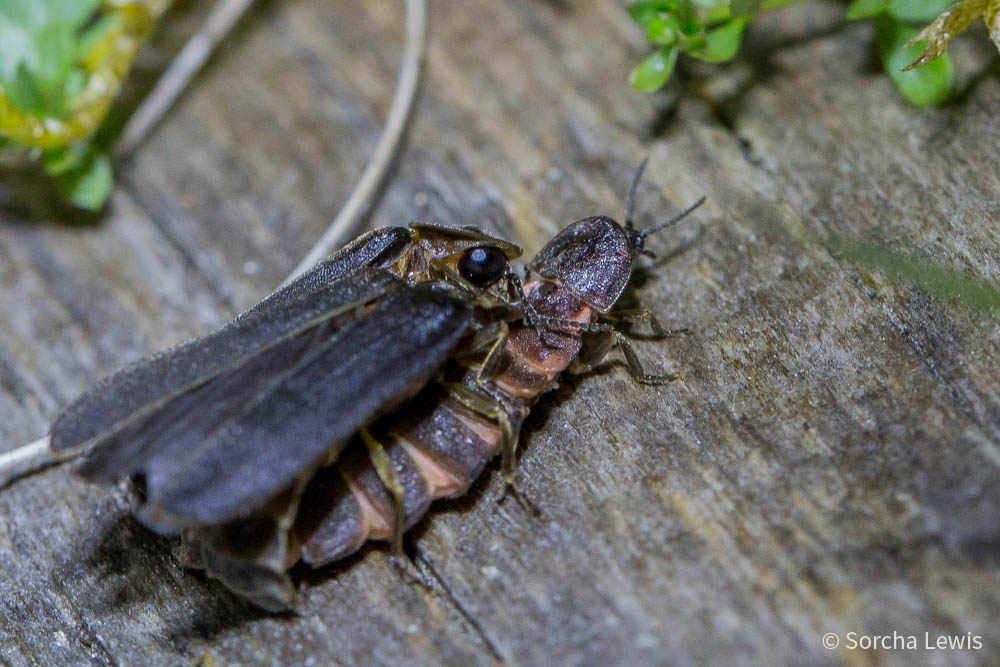

Moths
They might not be considered as beguiling and romantic as our fancy butterflies, but we really should look at moths in a new light. It’s about time time to blow away a few moth myths. They are not all dull and brown and considered the nocturnal poor relation of the beloved British butterfly. Nor are they all intent on eating holes in our favourite jumpers.
What is the difference between a moth and a butterfly? As always there are the exceptions to the rule but there are two general clues to look out for.
The antennae – moths have a long tapering shaped antennae which often is feather shaped (especially in the males as they use them for finding mates). Our butterflies tend to have matchstick-shaped clubbed antennae (straight with a blob on top).
When at rest the wings – butterflies tend to fold their wings upright on their backs like a book cover; most moths fold their wings flat.
Moth Myths
- Moths are nocturnal
- Moths are brown and drab
- Moths are always furry
- Moths are not butterflies
- All moths eat clothes
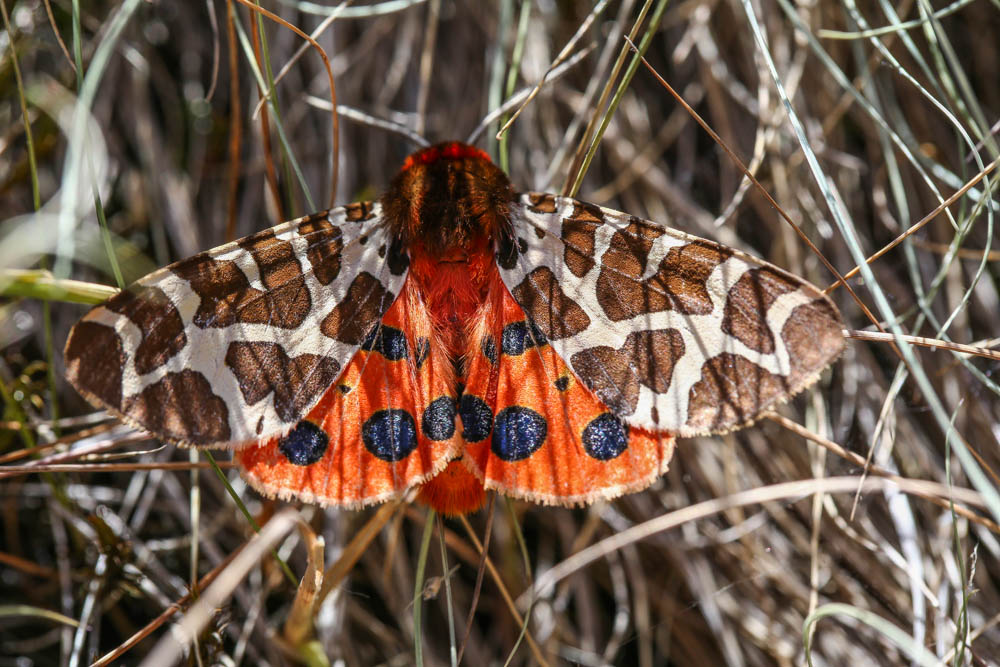
Moth Facts
You will find there are more day-flying moths in the UK than there are day-flying butterflies
Moths are ‘positively phototactic’ – they’re attracted to light which is where the saying “like a moth attracted to a flame” comes from.
There truly are just as many beautiful and colourful moths with such amazing patterns which would rival those of the butterflies.
Of the 2,500 species of moth, only two common species are responsible for eating clothes (and they attack only animal fibres such as wool)
Butterfly Conservation suggests that our blue tit population requires a staggering 35 billion moth caterpillars a year to feed to its dependant chicks.
Moths lay eggs, each of which hatches into a caterpillar (or larva) which feeds on various types of plant material. The caterpillars of some moths only eat one type of plant, whereas others will eat a much broader range. Usually it is the leaves that are eaten, but some caterpillars eat flowers, fruits, stems or roots. The caterpillar is the only stage of the life-cycle which grows, and as it does so it forms a new soft skin under the old one, which then splits and moults to allow the body to expand. When the caterpillar has reached full size, which could take from a few weeks to a few years depending on the species, it then pupates to form a pupa. Often they first build a cocoon, either from silk which they produce themselves or from pieces of plant material, and then pupate inside. The adult moth emerges from this cocoon and looks for a mate, and the cycle starts again.
Both the moths and their caterpillars are important food items for many other species, including amphibians, small mammals, bats and many bird species. Moth caterpillars are especially important for feeding the young spring chicks, including those of most familiar garden birds such as the Blue Tit and Great Tit, Robin, Wren and Blackbird. Moths are important pollinators, especially for night-scented flowers.
To try and avoid being eaten by the numerous predators, moths have evolved a variety of survival strategies. Both the adults and caterpillars may use camouflage to avoid being noticed, either through adopting subtle colours and patterns which resemble their background, or they may go for more bold patterns which break up their outline so that their shape is less recognisable. Some have also evolved shapes on their body that disguise them as other objects, such as caterpillars that resemble. The buff tip moth looks like a broken birch branch; these are recorded frequently on the estate.
There are other species that choose to be brightly coloured and patterned to warn predators that they are distasteful, such as both the adult moth and caterpillar of the Cinnabar and the Mullein caterpillar. Some have lovely eye-spots or bright patches to startle or confuse their predators, like the adult Emperor Moth and Elephant hawkmoth. Both found in the valley.
A serious decline in moth numbers could have disastrous knock-on effects for all these wildlife species in our countryside. Our decrease in moth numbers is a warning to us that all is not well with our environment. This has been another factor to improving our knowledge both in the Elan Valley and the County, a guide and a base to the future of moth conservation. It is another reason we have promoted moth events aimed at raising awareness and hoping to encourage more interest in our moths. Over 400 species of moth have been recorded here in the catchment and there is still much to do.
Some studies have found the overall number of moths has decreased by a third since 1968. The situation is worse in southern Britain, where moth numbers are down by almost half. Many individual species have declined dramatically in recent decades and over 60 became extinct in the 20th century.
Much of our research here is done using a moth trap which are a way of attracting night flying moths into a holding container (a box or bucket for example) using a light, so that they can be studied.
The moths are not harmed by the trap and once inside will rest in the container until they are released.
Moth traps use ultraviolet lights, to which moths are particularly attracted, but even a normal house light can attract moths – as you may know if you have ever left a light on next to an open window on a warm, still night!
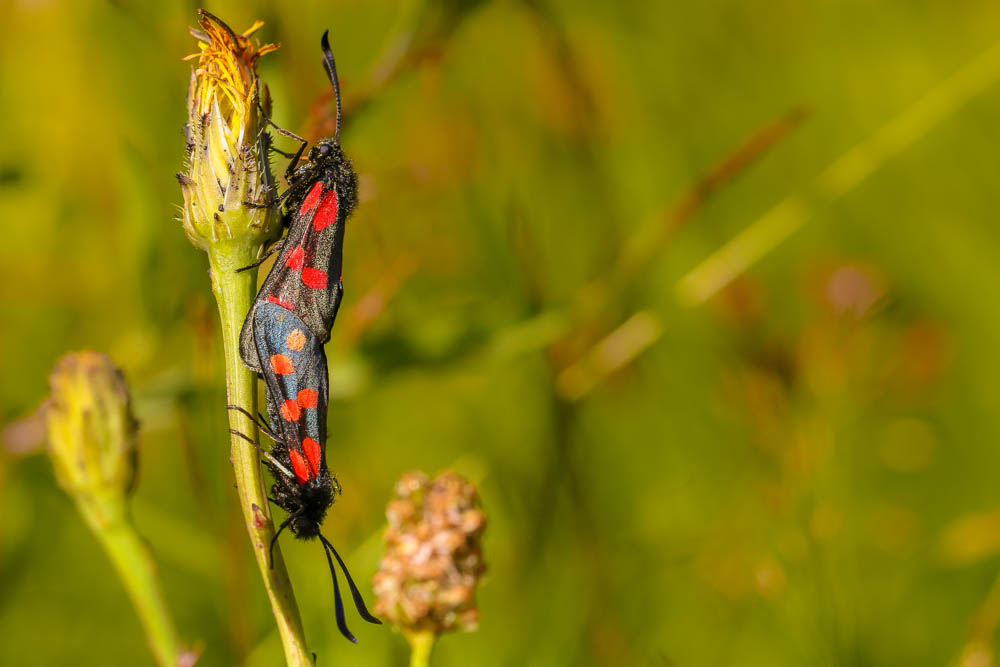
Some of the nicest moths you will find around the Elan Valley include…
Six Spot Burnet which flies with a usually slow buzzing flight during the sunny moments and is attracted to a range of flowers including thistles, knapweeds and scabious (all common in our meadows and along the Elan Valley Trail. A Good spot to see them on the trail is the section between Caban Dam and Garreg Ddu Dam and Penygarreg to Craig Goch. .Its food plant is Common Bird’s-foot Trefoil, but also occasionally on Greater Bird’s-foot Trefoil. The Caban section of the trail is a great place to find the similarly coloured Cinnabar moth. It can be distinguished from the similar burnet moths by its broader wings and red bars instead of spots. The Cinnabar moth caterpillars are bright black and yellow striped and seen on the ragwort. This is a good caterpillar to point out to the children when out walking or cycling along this section.
Chimneysweeper is a lovely moth that can be seen feeding on the flowers and seeds of Pignut (Conopodium majus). The Chimney sweepers are sooty black all over (hence their name), except for the white fringing at the tips of the forewings. The drab colour and lack of pattern could render these moths unremarkable however their swift flight and those moments when the light is seen catching on the black colouring makes them a delight to watch as they flutter through fields and meadows.
Double line moth was a former BAP species the moth breeds in both open woodland and damp grassland habitats, including streamside’s here in the Elan Valley. Very much associated with Rhos pasture. The moth flies during June and July. The larva feeds at night on grasses, especially cock’s-foot, wood meadow-grass and wood-rush.
The Scarlet tiger you will find occupying the damp areas such as rhos, marshes, river banks and quarries/rocky places. This is another one of our day-flying species of moth. The single generation flies in May and June.

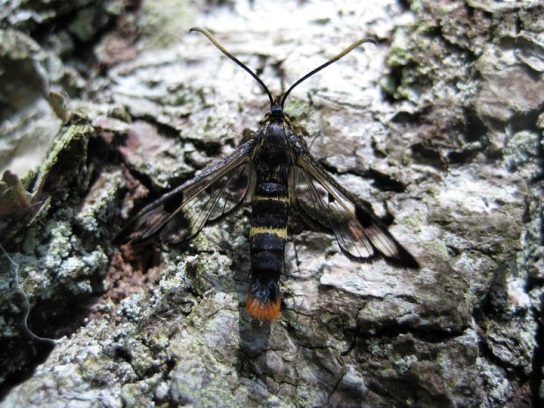
The Welsh Clearwing moth is a large (12-15mm) and conspicuous day flying moth with as the name suggests clear wings with black patches on the outer edge. The moth is characteristically black in colour with two yellow bands on the abdomen they have large black antennae with yellowish/white tips. The most distinctive feature o look out for is is the fan shaped tail which is large and orange in colour.
To have an opportunity to see this iconic moth it we would advise searching on warm sunny mornings during Mid-June to mid-July where you may happen upon an adult basking in the sun soon after it emerges. Welsh Clearwing is heavily associated with the birch trees (in particular the Iberian White Birch, Betula celtiberica) in the valley. Many of the single standing multi stemmed trees are the ideal places to have a look. If you examine the tree bark closely you may come across the confirmed presence and the activity of the Welsh clearwing; this is the “exuviae” or the skin left behind when the caterpillar turns to pupa and then as the clearwing adult emerges from the tree the cases in which they pupated can be caught in the bark, on mosses or in spiders webs. They may even be on the ground, they are quite fragile and papery so will easily be blown by the wind or knocked off buy the rain. They are a great clue that Welsh Clearwings are leaving this exact tree.
Poplar Hawkmoths are impressive and fly mostly in a single generation in late spring and early summer. A small second generation can occur in warmer regions. Despite its name you don’t have to live near poplars to see this hawkmoth. Its larvae here in the Elan Valley feed on various willows and sallows. This is the most widely distributed hawkmoth in Britain and is a common visitor to gardens. Both male and females are night flying and are attracted to light.
So the next time something flutters around your light, think twice before rolling up a paper.
.

